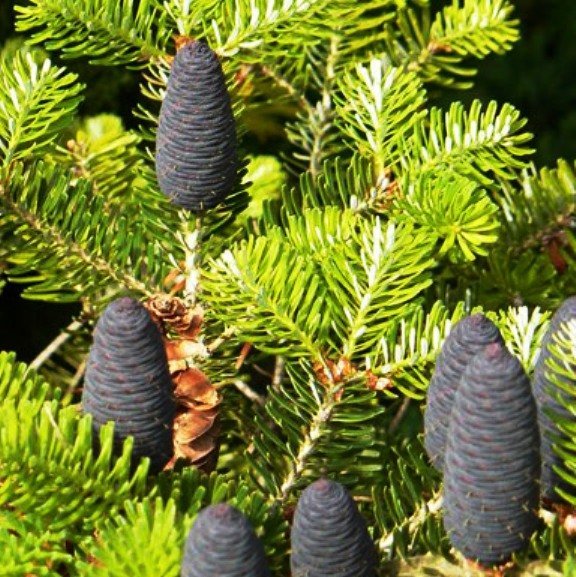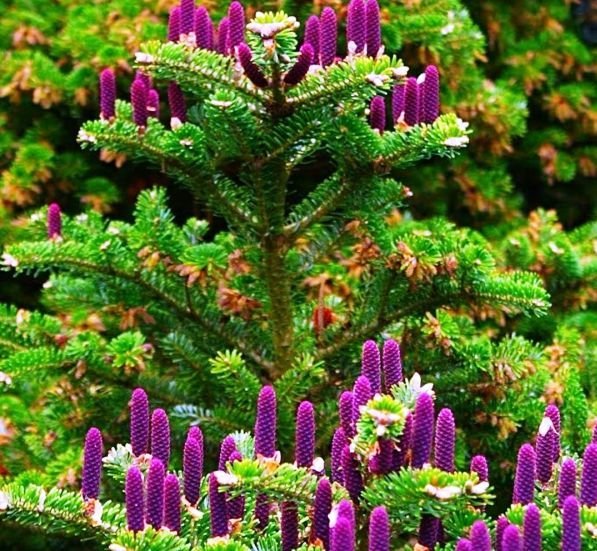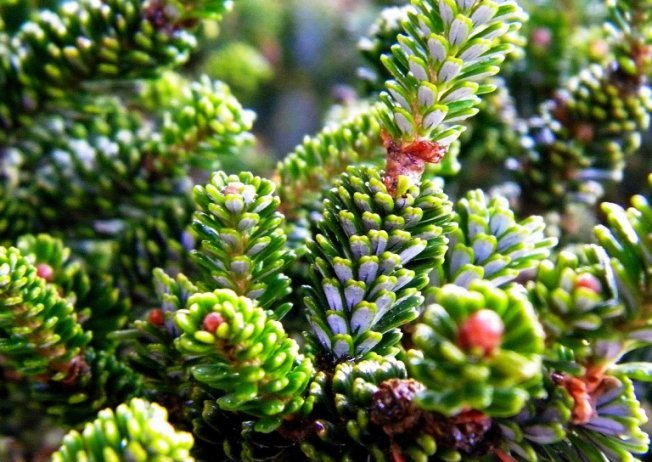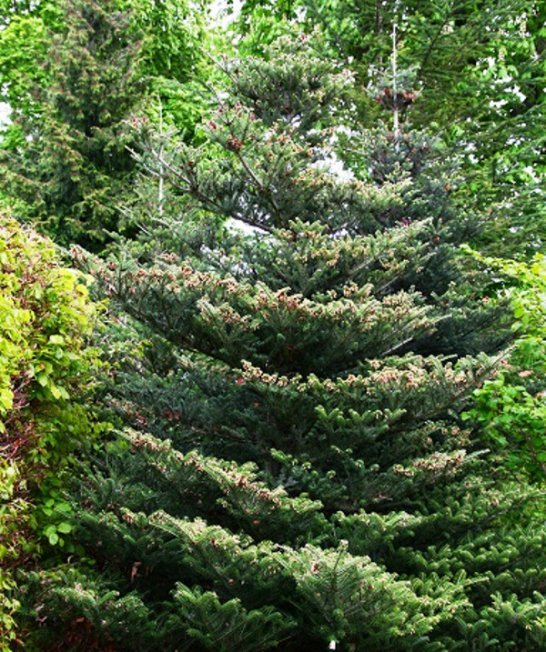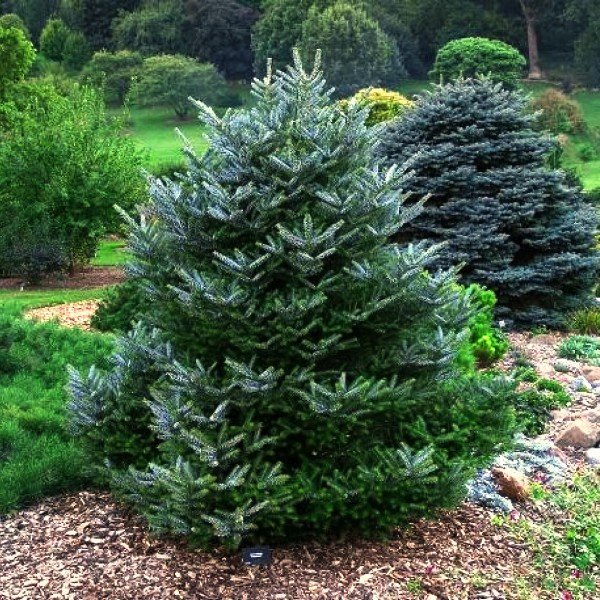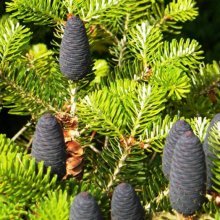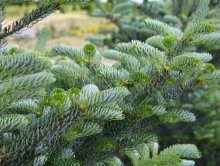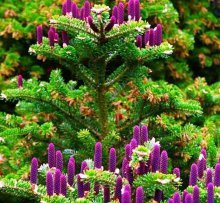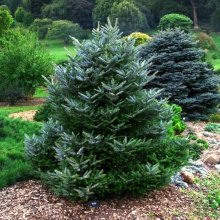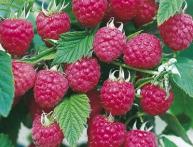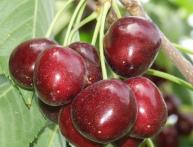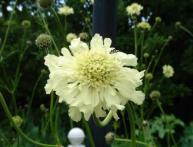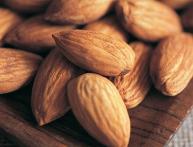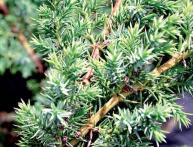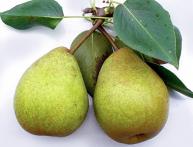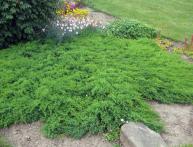Fir abies koreana, description, photos and characteristics, varieties, advice on agricultural technology
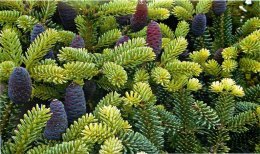
An evergreen coniferous tree, these are the words used to describe the abies koreana fir. This crop is widely used in creating landscape designs, for example, for organizing hedges or alpine slides.
But to avoid any problems, you need to familiarize yourself in advance with all the nuances of growing and the whims of this tree.
Content:
- Fir abies koreana, description of what the needles and fruits look like
- Where it comes from, distribution area
- Most popular varieties
- Planting Korean fir: lighting and soil requirements
- Recommendations for care: watering, fertilizing
- Pruning Recommendations
- Reproduction of fir abies koreana: seeds, layering, cuttings
- Control of common diseases and pests
- Using Korean fir in landscape design
- Reviews of abies koreana
Fir abies koreana, description of what the needles and fruits look like
Abies Koreana or Korean fir refers to conifer family. However, this species, unlike others, has a number of features.
Plant characteristics:
- The height of the tree reaches more than four meters.
- The crown shape is conical.
- The needles are short (its length is one or two centimeters), soft, dark green in color, with a slight shine. On the inside of the needles there are two light green stripes.
- The fruits are in the form of cylindrical purple cones.Their length ranges from five to seven centimeters, and their diameter is two and a half centimeters. The fruits ripen throughout the whole year, and at the end of autumn the cones open and seeds appear.
- The tree prefers a sunny area and is resistant to wind and cold.
Lives about one hundred and fifty years.
Let's watch an interesting video about the fir plant:
Where it comes from, distribution area
The habitat of the Korean fir is the southern part of Korea, namely the island of volcanoes called Jeju.
Thanks to its attractive needles and ease of care, the tree has gained leadership among its relatives and has spread throughout the world: in America, East and South Asia and European countries.
Most popular varieties
Let's look at the most widespread varieties and list them in Table 1.
| Variety name | Description and features |
| Diamond | It is a dwarf variety. It has an oval crown shape. At the age of ten years it will reach a height of just over half a meter. The needles are dark green in color; when young, they have a more saturated color and then darken. The length of the fruit is seven centimeters, the color is purple, with hints of green. |
| Compacta | The crown shape is spherical (sometimes cone-shaped). By the tenth year of life it reaches ninety centimeters in height. |
| Blue standard | The crown is conical or pyramidal in shape. In ten years it grows by one and a half to two meters. The color of the needles is dark green on the outside, and white-blue on the inside. The fruits are blue, purple or violet in color. |
| Molly | The tree grows very quickly, growing by five to seven centimeters in a year. The crown shape is pyramidal or cone-shaped. The shoots are branched, the trunk is even. Many fruits are formed, their color is blue-violet |
Planting Korean fir: lighting and soil requirements
When planting fir, special attention should be paid to the choice of land and soil.
Let's discuss site requirements. In this matter, the tree is quite demanding. Good lighting is a must. Lack of sunlight and even partial shade becomes disastrous for some varieties.
If tall trees grow near the chosen location, they should be removed, as their foliage will create shadow.
Almost any option is used as soil. The main thing is to refine and feed the soil. However, preference is given to acidic soils, sandy soil and soil with a large amount of organic additives.
Experts do not recommend using wetlands, as they have a high level of moisture. If it is not possible to purchase another place, then you need to install a drainage system.
Recommendations for care: watering, fertilizing
Classic care required:
- watering;
- weeding;
- feeding;
- pruning
Young seedlings need more water, as they are actively growing and strengthening their root system. As soon as planting has been carried out, after fifteen days the first watering is carried out, the procedure is repeated every fifteen days.
The same goes for container-grown trees. Mature trees are watered up to three times during the entire growing season. If there is severe drought, then water several times a month.
After watering, the soil is fluffed up and covered with mulch. For mulch, use pine needles or sawdust.
Fertilizing is carried out three years after planting. Special substances developed for the care of coniferous crops are used as fertilizers.
Pruning Recommendations
Korean fir needs sanitary pruning; it is carried out as a preventive measure against pests. Dry and diseased branches and cones are removed.
Pruning is also carried out to form the crown. The central shoots are pruned, this allows you to achieve branched and dense needles.
Reproduction of fir abies koreana: seeds, layering, cuttings
Reproduction by all these methods is effective. The main thing is to do everything right. For clarity, we will place the main points in Table 2.
| Reproduction method | Recommendations |
| Seeds | To obtain good material, the cones are picked in advance and then dried until the seeds ripen. Then stratification is carried out. Keep the seeds in a wet substrate and growth stimulator for thirty days. Planting is first carried out in containers and left in greenhouses. Planting in open soil is carried out at the end of October or beginning of March. |
| Cuttings | For propagation, only annual shoots are used. Carefully cut off the part with the apical bud, the length of which is fifteen to twenty centimeters. Dip one edge in Kornevin for 24 hours, and then place it in a container with soil mixed with humus and sand, and place it under film or glass. After a year, the containers are taken outside for hardening, and at the end of autumn they are replanted |
| By layering | This is the easiest method of all. In the spring, the lower shoots are dug into the ground five centimeters deep and secured with staples. For the winter they are insulated, and after a couple of years they are disconnected from the mother bush |
Control of common diseases and pests
Possible root rot. This occurs due to waterlogging of the soil.
Fungal diseases. For prevention, diseased branches are removed, and the cuts are treated with Bordeaux mixture and garden varnish.
Fungal infection occurs when the crown is very dense. Therefore, sometimes it is necessary to carry out sanitary pruning.
Possible damage from the following insects:
- leafworm;
- spruce moth;
- aphid;
- Hermes.
To avoid infection, trees are treated with insecticidal substances.
Using Korean fir in landscape design
Korean fir, due to its versatility, is widely used to create landscape designs. The tree looks harmonious with other shrubs, plants, trees and compositions of flowers and herbs.
For example, you can plant larch, maple, spruce and pine nearby. Although the needles look great when planted alone.
To create landscape design, abies koreana fir is used to create alpine slides, green hedges and rocky gardens, for public gardens and parks.
The main thing is to plant all the plants correctly, choosing shades and growth. For example, Chinese fir has dwarf varieties; they should be planted together with flower arrangements, small shrubs, such as juniper or thuja.
Let's watch a video about how beautiful the fir looks on the site and learn about the characteristics of different types of this plant:
Reviews of abies koreana
This plant is highly valued by gardeners. The reviews are mostly positive.
First of all, among the advantages is the slow growth of the tree, this allows you not to change the composition in the garden every year.
The species is also famous for its frost resistance, the absence of the need for pruning and the beautiful shape of the crown.
There are also negative reviews, many highlight one drawback - the plant is susceptible to attacks by harmful insects, especially aphids.
So, abies koreana fir is an excellent plant for creating landscape compositions, and is simply suitable as a garden decoration.Following the recommendations for care and planting will avoid all sorts of problems.

